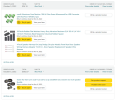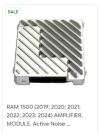From the Kicker kit you snipped, I'm guessing you've replaced the 6x9s in the front and rear doors plus the dash corners?
What factory audio system did you start with? Harman Kardon? Alpine? I'm guessing Alpine because I think I know the problem you're running into.
From your snip above, you've got 4 ohm replacement speakers, and I think the Alpine system uses 2 ohm speakers. 2 ohm speakers are more efficient at giving higher output, which is why a lot of factory audio systems like using them. When you switched to 4 ohm speakers, it's effectively like your maximum volume level dropped. In a general example, 20 watts at 2 ohms is roughly equivalent to 10 watts at 4 ohms, and if the factory system was limited to pushing 20 watts at 2 ohms, then it's now limited to pushing 10 watts at 4 ohms. I don't know the actual ratings of the factory alpine amp per speaker, but that's the math of what happened when you installed the Kickers. So now, when you're asking your volume knob for 20 watts at 4 ohms instead of 2 ohms, it's overdriving the factory amplifier, and the amplifier goes into protect mode when it builds up too much heat (or some other protection mechanism they built into it).
Bypassing the factory amplifier will require a few components. You'll need an OEM interface device of some sort. I used a PAC AP4-CH41 module and ran an optical connection to my system. Optical is best for automotive situations because vehicles with a lot of electronics can often introduce noise on traditional analog electrical signals. If you can buy an amplifier with an optical input, or a put a processor in series with your audio signal (with an optical input) that then routes to the aftermarket amplifier, you'll benefit. Otherwise, the PAC modules in my signature also has RCA outputs that can directly feed an aftermarket amplifier.
You'll need a truck (and options) specific harness. The CH41 might work for you depending on your year, or you may need to add the APH-CH42. There's also the optional TOSLINK adapter, the APA-TOS1 which is a simple modification to the CH41 endorsed by PAC.
You'll need power, ground, and remote turn on (REM) wires for your aftermarket amplifier. The PAC can provide you with the REM, or you can do a little research to find another accessory turn on lead from the truck. You don't want constant +12V for this or you'll drain your battery. If you only plan on adding a single amplifier, with no future plans to further upgrade, then you can buy an amplifier install kit that aligns with the power output of the amp you choose. They'll come with appropriate lengths of wire, terminations, a fuse holder and fuses, etc.
From there, check the RMS power rating of the speakers you have (watts), along with their impedance rating (the word here is "ohms" and the common ratings are 4 ohms and 2 ohms), and buy a 6+ channel amplifier capable of putting out
at least that much RMS power at the rated impedance . Ignore any references to "peak power". It's a meaningless rating used to sell cheap junk. Contrary to common sense, the leading cause of blowing speakers is driving them too hard with a weak/distorted signal because you're asking for more power than the amplifier can provide. Too much power is better than not enough, and you'll likely almost never be using all of this power anyway. Headroom is good. I can get into that in more depth if it would help. That said, if your budget is tight, it's not 100% critical that the amp meet the maximum RMS power rating of the speakers. More is better, but nearly anything will likely be better than the factory amplifier's output.
You'll need to consider the filter frequencies that you want to play each speaker at, likely based on it's manufacturer specified ratings, and make sure the amplifier has built in filtering that can protect them from playing bass and subbass frequencies accordingly. High pass (HPF), low pass (LPF), and band pass (BPF) may be the words you find on the amplifier's spec sheet. The 6x9s can likely handle a full range signal reasonably well, but the 3.5" would likely sound bad and potentially die if you played them without a high pass filter above the minimum frequency range from their spec sheet. There's also a bunch that goes into picking frequency pass bands for various speakers installed in different locations in the truck, etc. I can get into that with you at great detail, but you'll be fine ignoring that unless you pick up car audio as a full blown hobby. If it sounds fine to you now, it'll still sound fine after, and should get rid of your overheating factory amp problem.
If you're not hurting on bass, there's no need to introduce a subwoofer and a subwoofer amplifier. You're looking for a full range amplifier with at least 6 channels of amplification.
The 3.5" Kickers are rated for 30 watts RMS at 4 ohms with a recommended minimum frequency response down to 80 hz.
The 6x9 Kickers are rated for 90 watts RMS at 4 ohms with a recommended minimum frequency response down to 30 hz.
I'd be looking for a 6 channel amplifier capable of putting out
at least 50 watts RMS at 4 ohms that also had the ability to apply a high pass filter up to at least 80 hz. You'd set the amplifier gain lower on the 3.5" dash speakers since they're only rated up to 30 watts. You could also choose to leave the 3.5" speakers on the factory amplifier and just use a 4 channel to drive your door 6x9s. There's likely hundreds of amplifiers that can check these boxes within a fairly reasonable price range, and this would solve your "dropping out" problem since you'd be removing the main source of heat build up by taking the 6x9s off the factory amp.
This will solve your problem (just an example):
Kicker 46CXA360.4T
Here's one from the upper tier of solutions:
JL Audio VX800/8i
There are a lot of other great options in between too.














